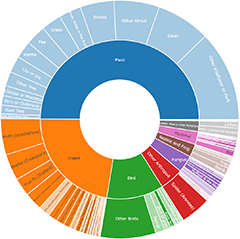Spiders
Tips for submitting spider sightings:
Photos from various angles are sometimes necessary for specific ID.
- front (eye arrangement, pedipalp colour)
- dorsal (above - general colouration, carapace and abdomen patterns)
- ventral (underneath - especially useful for some of the ground-dwelling families and orb-weaving families)
- side (further details for general shape, abdomen patterns and eye configuration)
- back (further details for abdomen pattern).
Comments or photos on the following also provides valuable information if/when such features are applicable and observed...
- surroundings and location (eg. ground, leaf litter, hand rail, tree trunk)
- web structure and silk use (eg. orb, messy & tangled, throwing silk)
- breeding (eg. display, egg sac)
- behaviour (eg. hunting, interaction, familiarity with people such as the threatening display of a huntsman or the friendly and curious jumping spiders that jump onto the camera lens)
- notable, unique, exciting or strange observations (eg. spur-like protrusions from legs, camouflage, mimicry)
Please note that the size of the spider is measured by body length.
- body size is from the top of the cephalothorax (head) to the tip of the abdomen without including the legs.
(Updated: October, 2022. Please feel free to message a spider moderator if you have any queries or suggestions for improvement)
Resources:
- Field guide: A Field Guide to Spiders of Australia authored by Robert Whyte & Greg Anderson
- A good introduction: http://www.ento.csiro.au/education/allies/araneae.html
- All about Australian spiders: http://www.arachne.org.au/01_cms/details.asp?ID=2409
Announcements
Hello NatureMaprsAs we move into the cooler months and sighting counts begin to wind down our team has been working tirelessly to ensure our platform’s usability and performance. All merch has been po...
Continue reading
Improvements to data import tool (coming soon)
NatureMapr welcomes Edgar McNamara
Platform wide attribute changes
New Feature: Moderator Quick Responses!
Discussion
I'm happy to keep it at family level, unless @EmmaCollins or perhaps @EathanDouglas is confident enough to ID to species level
Salticidae (family)
My confirmation of Salticidae on a family level at the moment doesn't discount your suggestion of Apricia jovialis - it very well could be and I'll quickly clarify my process!
Confirming this sighting to Salticidae is a reflection of my practice as a moderator, where I will only confirm to the level of ID of which I can be certain (wherever possible). This is to reduce the number of errors and the misinformation or confusion which may result from them. So, on occasion, I personally won't verify a sighting if there is uncertainty (Eg. for this individual, it appears to have significantly reduced setae, with notably faint colours on the legs. As the view is dorsal, it is difficult to gauge the proportions of the abdomen and so on). Often, I will confirm to a higher level of ID until I can undertake detailed research to eliminate the possibility of it being something I haven't considered. It's one way of managing my workflow, and getting some information back to you. It certainly doesn't work for everyone and the other spider moderators on NatureMapr can offer their own ID over mine at any time :)
On that note - if @NateKingsford or @EmmaCollins want to jump in here, they can offer their knowledge too! It's worth noting that we moderate on a volunteering basis with variable availability too.
Salticidae (family)
Salticidae (family)
Phonognatha graeffei
Recent activity
Top contributors
- Hejor1 2.1K
- AlisonMilton 1K
- TimL 836
- trevorpreston 790
- CathB 677
- ConBoekel 405
- Harrisi 391
- kasiaaus 326
- Christine 253
- jb2602 238
Top moderators
- MichaelMulvaney 7.3K
- YumiCallaway 1.4K
- NateKingsford 1.1K
- KimPullen 972
- EmmaCollins 778
- EathanDouglas 368
- MichaelBedingfield 293
- Bron 168
- Harrisi 112
- NedJohnston 53





